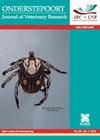The Potential Risk of International Spread of Mycobacterium Bovis Associated with Movement of Alpacas
IF 1.6
3区 农林科学
Q2 VETERINARY SCIENCES
引用次数: 4
Abstract
Abstract Introduction The study highlights the transboundary nature of tuberculosis (TB) in alpacas and the failure of current ante-mortem testing protocols (the tuberculin skin and Enferplex Camelid TB tests) to identify TB-free alpaca herds and individuals for export. Our research and the available literature indicate that the alpaca (Vicugna pacos) is extremely susceptible to Mycobacterium bovis infection, and that testing periodicity fails to take into account that animals do not manifest disease symptoms for a long time. The skin test failed to identify Mycobacterium bovis infection in two alpacas prior to their movement from the UK to Poland. The animals were purchased by a breeding centre in Poland, and were then shown at an international animal exhibition. The last owner of the alpacas before their deaths from TB bought the infected animals unwittingly in order to run rehabilitation activities with disabled children on his farm. Material and Methods Thoracic lymph node, lung and liver tissue samples obtained at necropsy were examined histopathologically after Ziehl–Neelsen staining. Tissue samples were homogenised and mycobacteria present there were cultured on Stonebrink’s medium during a 6-week incubation. A commercial test using polymorphism of the chromosomal direct repeat region provided species identification and additional identification was by spacer oligonucleotide typing and mycobacteria interspersed repetitive unit–variable number tandem repeat analysis with a gel electrophoresis protocol. Results The microbiological examination confirmed multiorgan TB caused by the SB0666 spoligotype of Mycobacterium bovis. Conclusion Due to the suboptimal performance of current diagnostic tests for TB in alpacas, there is a risk that infected animals may be moved unwittingly. A risk of TB spread associated with the international movement of alpacas is implied by this study.与羊驼活动有关的牛分枝杆菌国际传播的潜在风险
摘要:本研究强调了羊驼结核病的跨界性,以及目前的死前检测方案(结核菌素皮肤和Enferplex Camelid结核病检测)在确定出口的无结核羊驼群和个体方面的失败。我们的研究和现有文献表明,羊驼(Vicugna pacos)对牛分枝杆菌感染非常敏感,而且检测的周期性未能考虑到动物在很长一段时间内没有表现出疾病症状。在两只羊驼从英国转移到波兰之前,皮肤测试未能确定牛分枝杆菌感染。这些动物是由波兰的一个繁殖中心购买的,然后在一个国际动物展览会上展出。羊驼死于结核病前的最后一位主人无意中购买了受感染的羊驼,以便在他的农场为残疾儿童开展康复活动。材料与方法尸检获得的胸淋巴结、肺、肝组织标本经Ziehl-Neelsen染色进行组织病理学检查。组织样本均质化,其中存在的分枝杆菌在Stonebrink培养基上培养6周。利用染色体直接重复序列区多态性进行的商业测试提供了物种鉴定,并通过间隔片段寡核苷酸分型和分枝杆菌穿插重复单位可变数串联重复序列凝胶电泳分析进行了额外鉴定。结果微生物学检查证实由牛分枝杆菌SB0666 spoligotype引起的多器官结核。结论由于目前羊驼结核病诊断测试的性能不理想,存在感染动物在不知情的情况下被转移的风险。这项研究暗示了与国际羊驼运动相关的结核病传播风险。
本文章由计算机程序翻译,如有差异,请以英文原文为准。
求助全文
约1分钟内获得全文
求助全文
来源期刊
CiteScore
4.30
自引率
0.00%
发文量
13
审稿时长
16 weeks
期刊介绍:
The Onderstepoort Journal of Veterinary Research, is the official publication of the Onderstepoort Veterinary Institute. While it considers submissions from any geographic region, its focus is on Africa and the infectious and parasitic diseases and disease vectors that affect livestock and wildlife on the continent.

 求助内容:
求助内容: 应助结果提醒方式:
应助结果提醒方式:


